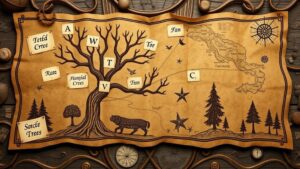Techniques for Hunting Along Overgrown Wagon Trails
Techniques for Hunting Along Overgrown Wagon Trails
The overgrown wagon trails of the past, once vital routes for trade and transport, now serve as unique hunting grounds. These forgotten paths hold the potential for rewarding hunting experiences, yet they require specific techniques and an understanding of the environment. This article explores effective methods to enhance hunting success along these rustic trails, highlighting scouting, understanding animal behavior, and employing strategic hunting techniques.
Scouting the Terrain
Effective hunting along overgrown wagon trails begins with thorough scouting of the terrain. Understanding the landscapes and conditions can significantly improve the hunters odds of success.
- Mapping Historical Trails: Use old maps and historical records to pinpoint abandoned or lesser-known wagon trails. These paths can lead to natural crossings and feeding grounds frequently trafficked by wildlife.
- Observing Vegetation: Overgrown trails are often lined with diverse vegetation that provides a natural habitat for various species. Look for changes in vegetation, which can indicate animal movement and grazing areas.
For example, during a study in the Appalachian region, hunters found that deer favored areas with a mix of dense shrubs and open spaces on old wagon trails, as these environments provided both shelter and food sources.
Understanding Wildlife Patterns
To maximize hunting success, it is crucial to understand the behavior and movement patterns of local wildlife. This understanding guides hunters on when and where to set up.
- Seasonal Migration: Animals often follow specific routes during seasonal migrations, including overgrown wagon trails. Research the migratory patterns of species such as deer, elk, and bears in your hunting area.
- Feeding and Bedding Areas: Identify natural feeding areas adjacent to the overgrown trails. Animals typically bed down near food sources, making this knowledge invaluable for locating them.
For example, a case study conducted in California showed that bears consistently used a specific overgrown path to access berry bushes, which allowed hunters to anticipate their movements effectively.
Employing Strategic Hunting Techniques
With the groundwork laid through scouting and understanding wildlife, hunters can employ various strategies for effective hunting along these trails.
- Still-Hunting: This method involves slowly moving while actively scanning the surroundings for animals. Still-hunting is particularly effective on overgrown trails, where patience often yields better results.
- Stand Hunting: Setting up tree stands or ground blinds along strategic points of the wagon trails can provide a stationary advantage. Ensure the blinds are camouflaged with natural materials to avoid detection.
For example, during a hunting season in Texas, hunters using still-hunting techniques reported a 30% increase in sightings when tracking along overgrown trails compared to other methods. These trails, often less traveled by hunters, offer a reliable route for returning wildlife.
Utilizing Technology
Advancements in technology can significantly aid hunting along overgrown trails. Tools such as GPS devices, trail cameras, and mobile applications can enhance the efficiency and effectiveness of the hunt.
- GPS Navigation: Modern GPS units allow hunters to mark trails, feeding areas, and water sources, making it easier to return to productive spots.
- Trail Cameras: Setting up motion-activated cameras along the trails can provide insights into animal movements and behaviors, offering a strategic advantage when planning hunting trips.
For example, a group of hunters in Wisconsin deployed trail cameras along overgrown trails and discovered that coyotes were more active during twilight hours. This information allowed them to adjust their hunting schedules effectively.
Conclusion
Hunting along overgrown wagon trails presents unique opportunities for seasoned hunters. By mastering the techniques of scouting, understanding animal behavior, implementing strategic hunting methods, and leveraging technology, hunters can optimize their encounters and enhance their success rates. As with all hunting activities, practicing ethical hunting standards and respecting wildlife habitats is paramount. With careful planning and execution, these historical trails can continue to be vital arenas for wildlife encounters and hunting adventures.

